Studio monitors are essential tools for any musician or producer. They provide accurate sound reproduction, which is crucial for making good mixing and mastering decisions. Studio monitors are also designed to be neutral, meaning that they don’t color the sound in any way. This makes them ideal for monitoring your music to ensure that it sounds good on a variety of playback systems.
There are many different studio monitors on the market, and it can be difficult to know which ones are the best for your needs. These are the top three features we have considered for choosing the best studio monitors under $500:
- Frequency Range: The frequency range of a studio monitor refers to the range of frequencies that it can reproduce. A wider frequency range will allow you to hear more detail in your music, which can be helpful for mixing and mastering. Studio monitors under $500 typically have a frequency range of 38Hz to 22kHz, which is sufficient for most musicians and producers.
- Driver Type: Studio monitors typically use either woofer and tweeter drivers or coaxial drivers. Woofer and tweeter drivers provide better separation between the low and high frequencies, while coaxial drivers are more compact and easier to place in a small studio. Woofer and tweeter drivers are generally the preferred choice for studio monitors, but coaxial drivers can be a good option for budget-minded musicians and producers.
- Connectivity Technology: Studio monitors typically offer a variety of connectivity options, such as XLR, TRS, and RCA inputs. Choose a studio monitor with the connectivity options that you need. If you plan on using your studio monitors with a professional audio interface, you’ll need a studio monitor with XLR inputs.
Discover essential insights in the comprehensive “Buying Guide” provided in the article, helping you make an informed decision on studio monitors under $500.
Outline
ToggleBest Studio Monitors Under $500 Table
| Best Studio Monitors Under $500 | Frequency Range | Driver Type | Connectivity Technology | Buy Now |
|---|---|---|---|---|
| M-Audio Studio Monitors | 69 Hz – 22 kHz | 3.5”woofer , 1”Tweeter | Auxiliary | Check On Amazon |
| JBL Studio Monitors | 49 Hz | 8 Inch woofer | XLR | Check On Amazon |
| Edifier Studio Monitors | 60Hz-20KHz | 4-W , 1 inch T | Auxiliary | Check On Amazon |
| KRK Studio Monitors | 56Hz to 30kHz | -- | -- | Check On Amazon |
| Mackie Studio Monitors | -- | 4" w , 0.75" T | Bluetooth | Check On Amazon |
| Samson Studio Monitors | -- | 5.25"w, ¾”T | Auxiliary | Check On Amazon |
| ADAM Audio Studio Monitors | 45Hz to 25kHz | 5 inch w, 1.9” T | RCA, XLR | Check On Amazon |
Best Studio Monitors Under $500 Reviews
1. M-Audio Studio Monitors
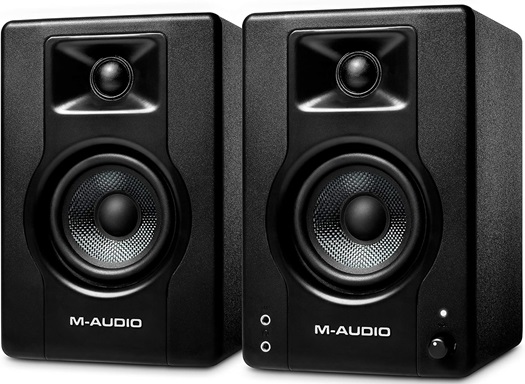
These studio monitors are not heavy, they weigh only 8 pounds. They are about 5.51 inches deep, 8.19 inches wide, and 5.71 inches tall. These speakers can connect to lots of different things like computers, smartphones, tablets, and record players.
Best Features:
- High-quality sound with 3.5-inch bass and 1-inch tweeters.
- Wide Frequency range from 69 Hz – 22 kHz.
- Easy sound customization with high and low controls.
- Versatile connectivity for various devices.
- Compact and lightweight design.
- Suitable for Recording and Multimedia
- Includes Music Production Software
- 120W Power
Pros:
- Excellent sound quality for various applications.
- Adjustable sound to fit your preferences.
- Easy to connect to different devices.
- Portable and space-saving.
Cons:
- External cables may be required for certain devices.
2. JBL Studio Monitors
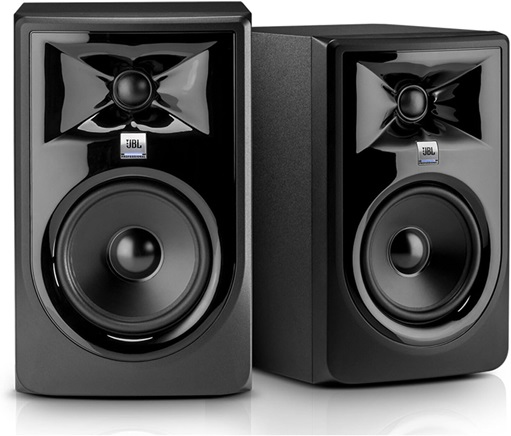
These speakers make your sound perfect to the original, with quick response and clear quality. The 305P has a special feature called Boundary EQ. It adjusts to your room and fixes low-frequency sound problems. It not only sounds good but also looks stylish in any workspace.
Best Features:
- Powerful 82-watt output
- Wide frequency range up to 49 Hz
- Image Control Waveguide for precise sound
- Innovative Boundary EQ for room adaptability
- 5-Inch 2-Way Powered Design
- Professional-grade Audio
- 49 Hz frequency range.
Pros:
- Clear, detailed sound
- Suitable for various tasks (music, podcasts, videos)
- Sleek and modern design
Cons:
- Not portable (requires a fixed setup)
3. Edifier Studio Monitors
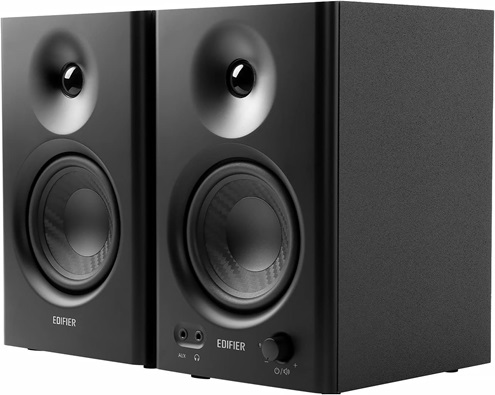
These speakers had a special feature that offers two different sound settings, one for work and one for enjoying music. It has a total power of 21 watts on each side, which means it provides strong and clear sound. These speakers can make all the sounds from deep and low to high and sharp because they can handle a wide range of frequencies, from 60Hz to 20KHz. It always gives you clear sound because they have little background noise (signal-to-noise ratio of ≥85dBA) and almost no distortion (≤0.2%).
Best Features:
- Near-flat response curve for accurate sound reproduction.
- Versatile connections with TRS, RCA, AUX, and headphone jacks.
- 1″ silk dome tweeters and 4″ woofers for detailed, balanced sound.
- Active Near-Field Monitors.
- Frequency range up to 60Hz to 20KHz.
- signal-to-noise ratio of ≥85dBA
Pros:
- Dual mode customization for different audio needs.
- Well-balanced and detailed sound with quality tweeters and woofers.
- Low background noise and distortion for clear audio.
Cons:
- Relatively small for very large studio spaces.
4. KRK Studio Monitors
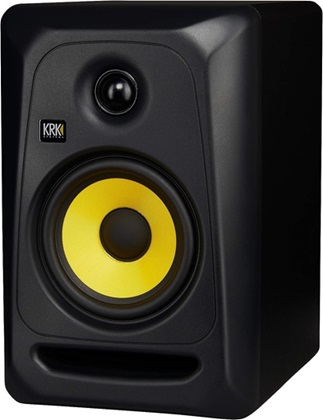
Moreover, you can use the low-frequency adjustment to fix any odd bass sounds caused by your room. It is a flexible and carefully made speaker for musicians, producers, and sound fans in any studio.
Best Features:
- High-quality 5″ woofer and 1″ tweeter for clear sound.
- Wide frequency range (56Hz – 30kHz) for detailed audio.
- Customizable high/low-frequency controls.
- Powerful 101dB peak SPL for immersive sound.
- Flat low-frequency adjustment for room correction.
- Room bass correction.
Pros:
- Precise sound reproduction.
- Versatile for different room sizes.
- Loud and immersive audio.
Cons:
- Not Ideal for compact spaces.
5. Mackie Studio Monitors
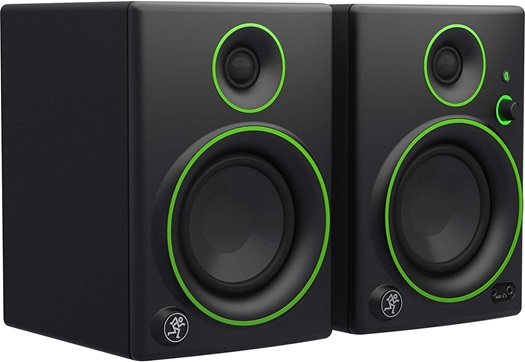
These monitors are small and look good. They won’t take up much space on your desk. These are perfect for making music, watching movies, or listening to your favorite songs.
Best Features:
- Professional-grade sound components for accuracy.
- Adjustable speaker placement for flexible setup.
- High-Quality Sound
- Strong 50-watt amplifier
- Green Trim Accents
- 4-inch Woofer and 0.75-inch tweeter
- Bluetooth Connectivity
- Front-facing headphone output for private listening.
Pros:
- High-quality sound with deep bass and clarity.
- Versatile input options for various devices.
- Bluetooth capability for easy wireless connections.
- Compact and stylish design fits well in workspaces.
Cons:
- No remote control included.
6. Samson Studio Monitors
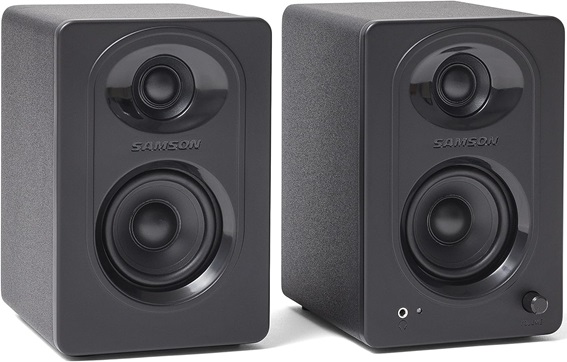
It is versatile, allowing you to control your sound the way you like. The headphone jack lets you focus on your work quietly, even during late-night editing. Moreover, you can add a subwoofer to make your sound more powerful. It offers a perfect balance of power, precision, and adaptability.
Best Features:
- Compact and space-saving design.
- 20-watt amplifier for quality sound.
- Bass boost EQ switch for sound customization.
- 3-inch woofers and 3/4-inch tweeters.
- Subwoofer output for enhanced bass.
- 3″ Powered Studio Monitors
- High-Quality Sound
- Compact Pair
Pros:
- Clear and balanced sound quality.
- Versatile for various audio needs.
- Space-efficient and stylish design.
- Private listening option with headphone output.
Cons:
- Limited power for extremely loud volumes.
7. ADAM Audio Studio Monitors
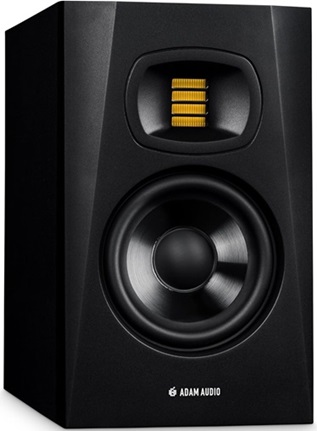
This speaker uses a strong 50W amplifier for the bass and a 20W amplifier for the high sounds, which is more powerful and precise audio.
Best Features:
- Wide frequency range (45Hz-25kHz)
- High maximum sound level (106dB)
- Quality 5″ woofer and U-ART tweeter
- Compact and affordable
- Ideal for small control rooms
- 50W amplifier for the bass
- Precise and powerful audio
Pros:
- Excellent sound quality
- Versatile for music, video, and broadcasting
Cons:
- Limited bass depth due to compact size
Buying Guide For The Best Studio Monitors Under $500
1. Frequency Range
The frequency range of a studio monitor refers to the range of frequencies that it can reproduce. For most studio applications, a frequency range of 40Hz to 20kHz is ideal. This range will allow you to hear the important frequencies in music, including the low bass notes, the high treble notes, and everything in between.
2. Driver Type
Studio monitors typically use two different types of drivers: woofers and tweeters. Woofers are responsible for reproducing the low frequencies, while tweeters are responsible for reproducing the high frequencies.
3. Connectivity Technology
When choosing studio monitors, consider the available connectivity options. Studio monitors typically offer a variety of connectivity options, including XLR, TRS, and RCA inputs. Some monitors may also offer digital connectivity options such as USB or AES/EBU. Additionally, check for features like balanced connections to reduce interference and signal noise.
4. Active Vs Passive
Active studio monitors have built-in amplifiers, which makes them easier to set up and use. Passive studio monitors require an external amplifier, which can be more expensive and complicated to set up.
In general (active Vs passive), active studio monitors are a better choice for most beginners and intermediate producers. Passive studio monitors may be a better option for experienced producers who already have an external amplifier and want more control over their sound.
5. Sound Quality
The most important factor to consider when choosing studio monitors is sound quality. Studio monitors should provide accurate and reliable sound reproduction. The benefits of sound quality in studio monitors are significant and essential for various aspects of audio production and mixing.
6. Durability
Studio monitors are used for long hours in professional settings, so it is important to choose a durable pair. These are well-built and made from high-quality materials. Studio monitors should be built to withstand the demands of daily use. Robust construction, quality materials, and well-protected drivers are all indicators of durability.
7. Compatibility
When choosing studio monitors, it is important to make sure that they are compatible with your other audio equipment. They can be easily integrated into your setup, whether it’s a small home studio or a professional recording environment. Compatibility with different audio interfaces and room acoustics is essential for optimal performance.
Studio Monitors – FAQs
Ans: Studio monitors are expensive due to their high-quality components and precise engineering, which ensure accurate audio reproduction for critical professional tasks like recording and mixing.
Ans: It’s not necessary, but adding a subwoofer can enhance low-frequency monitoring, especially for tasks like music production or mixing where precise bass response is crucial.
Ans: The choice of woofer size for studio monitors depends on your specific needs and room size. A 5 to 8-inch woofer is common for small to medium-sized studios, while larger rooms may benefit from 8 to 10-inch woofers.
Ans: In most cases, a pair of studio monitors (2) is sufficient for stereo sound monitoring. Additional monitors may be used for surround sound setups or specific production needs, but two is the standard setup.
Conclusion
Here are the top 3 recommendations for the above-given products, as these three studio monitors offer the best combination of frequency response, clarity, and accuracy in this price range. They are also all well-respected brands with a good track record.
- If you’re looking for the most accurate sound reproduction possible, the Mackie Studio Monitor is the best choice on this list. It has a wide frequency response and excellent clarity and accuracy.
- The Edifier MR4 Studio Monitor Speakers, provide versatility and value. These active near-field monitors with a 4″ woofer and tweeter offer a balanced sound. Their unique built-in microphone adds convenience.
- The M-Audio BX3 Studio Monitors, with their 120W power, versatile HD performance, and included music production software. They offer an affordable solution for recording and multimedia needs.
Ultimately, the best studio monitors for you will depend on your individual needs and preferences. Be sure to consider the factors above when making your decision. Feel free to share your queries or experience with us in the comments section below, we’ll respond and resolve them promptly.

